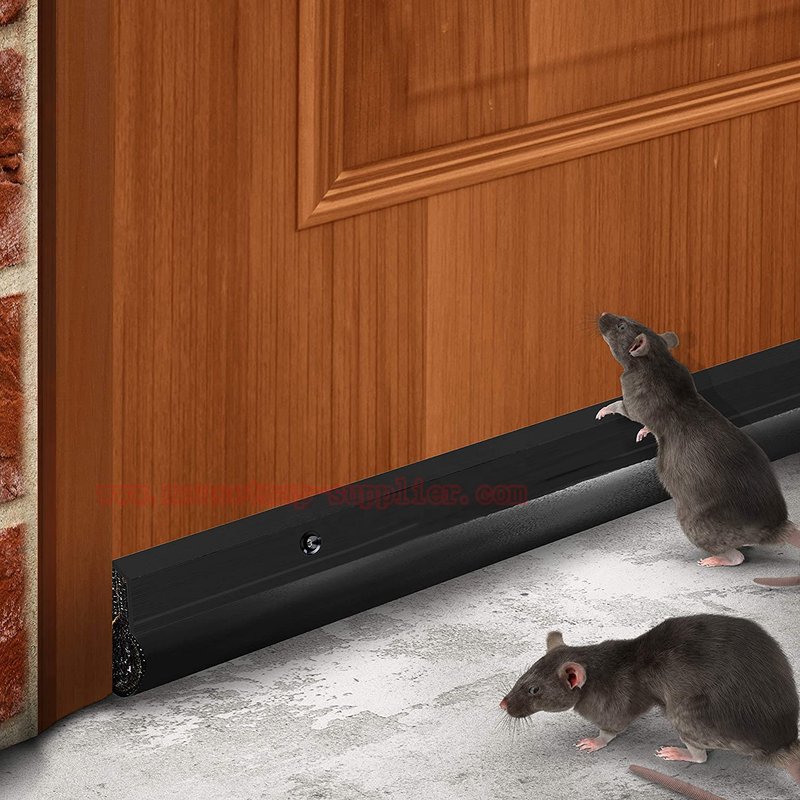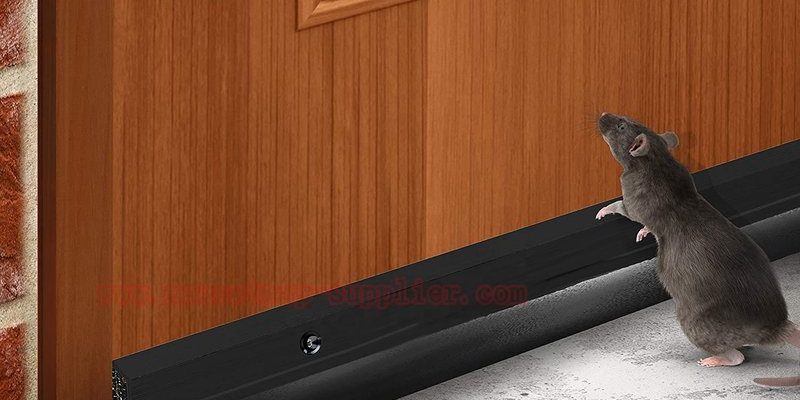
Door sweeps act like a security guard for your home’s weakest defense: that slim, often-forgotten space at the bottom of your door. Picking the right one isn’t just about blocking out a bit of cold air; it’s about putting up a solid, consistent barrier that stops pests from charging straight in. You’ll see a bunch of options and brands, from the classic Frost King to beefier choices like Suptikes or heavy-duty silicone models. The real question? Which door sweeps actually keep out mice and insects—and how do you choose without getting overwhelmed by technical mumbo-jumbo? Let me walk you through it.
Why Pests Love Door Gaps (And Why Sweeps Matter)
You might be wondering why that tiny gap matters so much. Mice can squeeze through holes as small as a dime—around 1/4 inch. Insects are even less picky; ants and spiders practically waltz through the slightest crack. Your doors, especially the ones leading outside or to garages and basements, tend to shift and settle over time. That creates uneven gaps that most weatherstripping can’t handle.
Here’s the thing: a door sweep isn’t just a draft-stopper; it’s pest control in disguise. When fitted correctly, a quality sweep covers that bottom edge like a shield, keeping unwanted critters (and sometimes even water and dust) out. No matter how clean your home, an untended door gap invites trouble—think of it like leaving a side window cracked open, except closer to the floor where pests roam.
Honestly, most people notice how much a door sweep helps the first time they see fewer bugs or droppings indoors. Even if you’re renting, a cheap, simple sweep can save you a lot of stress, pest-control bills, or awkward “mouse in the pantry” moments.
Types of Door Sweeps: Which Works Best for Mice and Bugs?
Not all door sweeps are created equal. You’ll find a few main styles, and knowing the difference makes a big impact:
- Brush sweeps: These have stiff bristles, almost like a giant toothbrush, and work well for uneven floors. But, honestly, bristles can sometimes flatten over time and let tiny insects sneak past.
- Vinyl and rubber blade sweeps: These give you a solid, flexible strip that covers the gap. For true pest-blocking power, you want a sweep where the blade flexes to press firmly against the floor. Mice can’t chew through quality rubber or silicone as easily as you’d think.
- Aluminum holder with silicone/rubber blade: This is the heavy-duty choice. The rigid metal holds a thick blade tight against the floor, making it tough for anything to push past or chew through.
Let me explain—if your door faces the outside or a dirty back alley, go with a blade-style sweep, preferably one with thick silicone. For light indoor use, like keeping bugs out of a pantry, a bristle sweep is decent. But for real pest defense? Skip thin vinyl or foam sticks. They wear out, and mice especially can gnaw through them in a weekend.
Features to Look For in a Pest-Blocking Door Sweep
When you start shopping, you’ll see words like “universal fit,” “adjustable,” or “easy install.” Here’s what matters if your main goal is stopping pests:
- Material: Go for silicone or thick rubber blades. Thin foam or plastic sweeps can be chewed, while bristles let smaller bugs through.
- Length and width: Measure your door carefully. You want the sweep to stretch all the way across, with no gaps at the sides. Some are “cut to fit”—just use a hacksaw or heavy scissors.
- Mounting style: Some sweeps screw into the door (more durable), while others “slide-on” or stick with adhesive (faster but sometimes less secure).
- Height adjustment: Look for models with slotted mounting holes or adjustable heights. That way, you can get the blade to press tightly without dragging hard on the floor.
You might be tempted by the really cheap adhesive vinyl sweeps you find in big-box stores. Honestly? They’re quick but usually start peeling within a month, especially if your floor isn’t perfectly smooth. For long-lasting pest control, take the time to install a screw-in type if you can.
Tip: Always clean and dry the door bottom before installing any sweep. Adhesive or screws need a dust-free surface, or the sweep might not stay put.
Top Door Sweep Brands and Models for Pest Prevention
Let’s talk brands and which ones actually live up to the hype for blocking out mice and insects. I’ve seen it firsthand—some sweeps look promising but end up letting critters slip by or fall apart after a season.
- Suptikes Door Draft Stopper: This silicone option is easy to cut and sticks with strong adhesive, but it’s thicker and heavier than most peel-and-stick versions. It’s a favorite for quick installs on rental doors, and the dense silicone blade means mice can’t chew through it easily.
- Holikme Door Sweep: Another popular silicone sweep. The flex is just right for uneven floors, and it’s tough enough for regular door use. It’s best for interior doors or doors with light weather exposure.
- Frost King Aluminum and Rubber Door Sweep: This classic has a sturdy aluminum strip and a thick rubber blade. It screws into the door, so it stays put even with heavy foot traffic. It’s reliable for both interior and exterior use and is tough enough to keep out even persistent pests.
- M-D Building Products Commercial Door Sweep: These heavy-duty models are made for serious pest sealing. If you have wide gaps or a commercial entrance, their thick rubber and rigid frame create a barrier mice and insects won’t cross.
The main takeaway? Don’t just pick the cheapest pack. Look for brands with solid materials and real user reviews mentioning pest prevention. The combo of a dense blade and a snug fit is what keeps the little invaders out.
How to Install a Door Sweep for Maximum Pest Protection
Mounting a door sweep seems straightforward, but a sloppy install can leave gaps—exactly what you’re trying to avoid. Here’s how to get it right:
- Measure the door width: Use a tape measure to get the exact length. Most sweeps come in standard sizes (36″ is common), but you’ll want a custom fit.
- Trim to size if needed: Silicone and vinyl sweeps can be cut with heavy scissors, while metal-backed sweeps need a hacksaw or a sharp utility knife.
- Mark the mounting points: Hold the sweep up to the door’s bottom, flush with both edges. Use a pencil to mark screw holes (or a line for adhesive placement).
- Test the sweep fit: Close the door and check that the blade touches the threshold all the way across. It should press firmly but not drag. Adjust height if possible.
- Attach: For adhesive sweeps, peel and stick with pressure. For screw-in sweeps, pre-drill holes if your door is wood or metal, then screw the sweep in place.
After install, open and close the door a few times. You should feel some resistance, but not so much that it’s hard to move. Check for light coming through underneath—if you see any, that’s where pests can sneak in. Adjust or trim as needed. Honestly, a five-minute check can save you tons of frustration (and pest encounters) later.
Common Mistakes to Avoid with Door Sweeps
Here’s where people trip up (sometimes literally). If your sweep isn’t working, it’s usually one of these reasons:
- Not cleaning the installation area: Dust and grease keep adhesive from sticking, and screws can loosen in soft or rotten door edges.
- Leaving gaps at the ends: Even a tiny open spot at the corners can be a welcome mat for ants or mice.
- Using the wrong sweep for the floor type: If your threshold is uneven, a rigid blade might leave spaces. Consider a flexible silicone or bristle sweep for bumpy floors, but remember bristles aren’t as mouse-proof as solid blades.
- Neglecting regular checks: Sweeps wear down over time—rubber can split or compress, and screws can work loose. Check yours every season, especially in high-traffic areas.
If you’re pairing your sweep with other pest barriers (like weatherstripping or door seals), make sure everything lines up tightly. Gaps anywhere are an invitation for critters. And if you spot chew marks or torn edges, it’s a sign you need to replace your sweep with something tougher.
Alternative Pest-Blocking Methods If Sweeps Aren’t Enough
Sometimes, especially in older homes, a door sweep alone can’t do all the heavy lifting. If you’re still dealing with pest issues, here are a few more steps you can try:
- Threshold plates: These metal strips install directly on the floor beneath the door, raising the surface and giving the sweep something solid to press against.
- Weatherstripping for jambs: If gaps run up the sides or top of the door, self-adhesive foam or rubber strips can close them off.
- Steel mesh “rodent guards”: These attach to the lower corners of doors and are almost impossible for rodents to chew through.
- Concrete or caulk filling: If the gap is under the threshold itself (not the door), sealing cracks with concrete or silicone caulk can block entry points.
You might be dealing with a combo of issues—uneven floors, warped doors, or old frames. Layering up your defenses helps, especially if mice or cockroaches are finding creative new ways to get inside.
How Door Sweeps Help With More Than Just Pests
While you’re focused on mice and insects, it turns out a good door sweep does even more heavy lifting. Think about it—sealing up that gap keeps out cold drafts in winter, traps cool air inside during summer, and can even block outdoor dust and pollen. If you have allergies, it’s a small step that pays off every day.
And here’s something a lot of people don’t realize: door sweeps can help with noise, too. That tight seal along the bottom muffles sounds from hallways or outside traffic. In apartments or shared buildings, it’s a surprisingly nice bonus.
In a way, investing in a door sweep feels like giving your door a little upgrade. Suddenly, those weird creaks, cold spots, or random insect invasions don’t bother you as much. It’s easy to overlook until you notice how much more comfortable, quiet, and pest-free your space feels.
Key Takeaways: The Best Door Sweeps for Pest Prevention
If you’ve ever wondered why pests keep showing up even though you keep a tidy house, the answer might be hiding just under your door. Honestly, a door sweep isn’t flashy or expensive, but it’s one of the most effective DIY fixes for blocking mice and insects.
Thick silicone or rubber blade sweeps (like Suptikes or Frost King) give the best defense against pests, especially when properly installed. For the most stubborn doors or toughest invasions, commercial-grade sweeps or added threshold plates can turn the tide. Just remember: measure carefully, clean before you attach, and check regularly for wear.
Any door leading outside—or to a garage, basement, or pantry—deserves a strong sweep. Once you fit yours and feel that snug seal, it’s like closing the last loophole in your home’s defenses. And with fewer pests to worry about, you can finally enjoy your space, no mouse traps or frantic midnight bug chases required.
